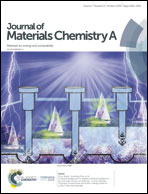Insight into the reaction mechanism of water, oxygen and nitrogen molecules on a tin iodine perovskite surface†
Abstract
In this article, in order to study the lead-free perovskite CH3NH3SnI3 (MASnI3) reaction mechanism between perovskite surface molecules and gas molecules, we fabricated models for three different gas molecules adsorbing on an MASnI3 surface. First, the surface energies of seven low-index surfaces ((100), (010), (001), (110), (101), (011) and (111)) of orthorhombic MASnI3 were calculated by density functional theory (DFT). The results showed the (011) surface was the most stable among the seven low index surfaces by the PW91 method. Secondly, three stable configurations were sorted out from these adsorption models of different molecules (H2O, O2, N2) at six positions on the (011) surface. For H2O, O2 and N2 adsorption, the smallest adsorption energies were −1.931(934) eV, −0.134(67) eV and −0.049(523) eV, respectively. The stabilities of configurations for H2O adsorption were affected by the strong interaction of the H–I bond. However, for O2 adsorption, the Sn–O bond and charge transfer between the Sn atom and O atom mostly affected the stability of the configuration. We found that the MASnI3 surface under a N2 atmosphere maintained a higher stability than in the other two cases. In addition, we further confirmed that the mechanism of H2O adsorption was not the same as O2 and N2 molecular adsorption from the Mulliken population, energy band and electrical density of state calculations. These results indicated that the H–I bond and Sn–O bond mainly affect the Sn–I bond, leading to MASnI3 stability being worse in H2O and O2 environments, respectively, and performance in a N2 environment is more stable than in O2 and H2O environments. This investigation enhanced understanding of the degradation of perovskite and provided some suggestions for developing more stable lead-free perovskite solar cells and devices.



 Please wait while we load your content...
Please wait while we load your content...